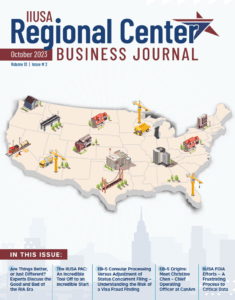In its recent report, “Chinese Investment in the United States: Recent Trends in Real Estate, Industry, and Investment Promotion,” a staff member and intern in the U.S.-China Economic and Security Review Commission paint an inaccurate and unbalanced picture of the EB-5 Program.
We welcome dialogue with members of Congress and the Administration to strengthen the integrity of the EB-5 program and ensure that its economic benefits are fully realized. That dialogue, however, must be based on accurate factual information about the program.
Contrary to the report’s claims, the EB-5 program is highly regulated.
- Recognizing the complex nature of the EB-5 program, USCIS has established an Immigrant Investor Program Office which is staffed by trained economists, experts in business and immigration law, as well as fraud and national security specialists. The agency has clarified its guidance for adjudicators with a comprehensive policy memorandum and has strengthened inter-agency relationships critical to program oversight and implementation.
- In addition, all investment offerings made by EB-5 Regional Centers are subject to U.S. securities and anti-fraud laws and regulations, enforced by state securities regulators and the U.S. Securities & Exchange Commission and private right of action.
We find it particularly curious that the report makes several references to “local authorities” certifying and screening EB-5 investors. As with any visa category, the process for adjudicating EB-5 investor petitions for eligibility and admissibility to the U.S. resides solely with the federal government.
Additionally, the report mistakenly insinuates that the approval of a Targeted Employment Area (TEA) on an I-526 petition is an automatic approval for a green card when in fact approval of a TEA is just one of many components that eventually equate to an investor’s conditional green card. USCIS regulations always have authorized states to designate geographic or political areas that have a weighted average of 150% of the unemployment rate of the nation using DOL-accepted methodology and the most current available data.
The report also misstates key facts about EB-5 Regional Centers, the federally designated entities that pool EB-5 capital from multiple foreign investors for investment in USCIS-approved economic development projects within a defined geographic region. Specifically:
- Existing Regional Centers include entities that are publicly owned and operated by state economic development agencies as well as public-private partnerships and private sector investment companies.
- Regional Centers and project developers use well-accepted economic analysis models, including those developed by the U.S. Department of Commerce, to demonstrate that job creation targets required by law (10 jobs per EB-5 investor) have been achieved.
The EB-5 Regional Center Economic Development Program successfully spurs U.S. job creation and economic growth by attracting foreign direct investment in the United States. A comprehensive peer-reviewed economic study found that during fiscal year 2012, the EB-program contributed $3.39 billion to U.S. GDP and supported over 42,000 U.S. jobs during fiscal year 2012. This is more than a 100 percent increase from the average annual impact result reported in 2011.
And yet, the report discounts these benefits. Following the 2008 economic crisis, access to capital was severely constricted and municipal budgets are still facing significant shortfalls. Investments made through EB-5 Regional Centers provide a new, vital source of funding for local economic development projects, often in partnership with local governments and economic development agencies. That is why the U.S. Conference of Mayors and the National Association of Counties have endorsed reauthorization of the Program.
Successful projects are revitalizing communities across the country, creating and supporting jobs, infrastructure and services. These projects include:
- Redevelopment of a closed Air Force base in Southern California into a vital commercial area including a distribution center and regional airport
- Development of assisted and retirement living communities in Washington State, creating 800 jobs and serving approximately 130 seniors
- The transformation of the closed Navy yard in Philadelphia into a dynamic, multi-use development now home to 130 companies and 10,000 employees
- Restoration of the historic “Alaska Club” building in Seattle, creating a modern hotel that employs almost 100 full-time jobs today and serves over 100,000 hotel guests annually
- Expansion of a one season ski-resort in Vermont into a thriving four season vacation destination
- Rehabilitation of a 100 year old building into a hotel that created of 161 jobs while kick-starting the revitalization of an historic Dallas neighborhood
We urge the Commission to revise the EB-5 section of its report to present a more balanced – and accurate – analysis of the EB-5 program.







